Articles
- Page Path
- HOME > J Korean Acad Nurs > Volume 39(5); 2009 > Article
-
Original Article
- Test of Validity and Reliability of the Adolescent Mental Problem Questionnaire for Korean High School Students
- Soo Jin Kim, Chung Sook Lee, Young Ran Kweon, Mi Ra Oh, Bo Young Kim
-
Journal of Korean Academy of Nursing 2009;39(5):700-708.
DOI: https://doi.org/10.4040/jkan.2009.39.5.700
Published online: October 31, 2009
1Professor, College of Nursing, Chonnam National University Chonnam National University Research Institute of Nursing Science, Gwangju, Korea.
2Assistant Professor, Department of Nursing, Chosun University, Gwangju, Korea.
3Part-time Lecturer, Department of Statistics, Chonnam National University, Gwangju, Korea.
4Psychiatric Mental Health Nurse, Gwangju Namgu Mental Health Center, Gwangju, Korea.
- Address reprint requests to: Kweon, Young-Ran. Department of Nursing, Chosun University, 375 Seoseok-dong, Dong-gu, Gwangju 501-759, Korea. Tel: 82-62-230-6325, Fax: 82-62-230-6329, yrk@chosun.ac.kr
Copyright © 2009 Korean Society of Nursing Science
Abstract
-
Purpose
- This study was done to test the validity and reliability of the Adolescent Mental Problem Questionnaire (AMPQ) for Korean high school students.
-
Methods
- The AMPQ was designed to assess adolescents' mental health status and problem behavior (Ahn, 2006). A methodological study design was used with exploratory factor analysis, Pearson's correlation coefficients, and a fitness of the modified model for validity. Also, Cronbach's alpha coefficients and alternative-form method for reliability were used. AMPQ was tested with a sample of 36,313 high school students. The participants consisted of 18,701 males and 17,612 females.
-
Results
- Seven factors were extracted through factor analysis: 'Psychiatric problems', 'Delinquency', 'Academic troubles', 'Family problems', 'Hazardous behavior', 'Harmful circumstance', 'Eating problems'. These factors explained 51.1% of the total variance. The fitness of the modified model was good (χ2=38,413.76, Goodness of Fit Index [GFI]=.94, Adjusted Goodness of Fit Index [AGFI]=.93, Comparative Fit Index [CFI]=.95, Root Mean Square Error of Approximation [RMSEA]=.05), and concurrent validity with Korea-Youth Self-Report [K-YSR] was .63. Cronbach's alpha coefficient of the 31 items was .85.
-
Conclusion
- The results of present study suggest that the modified AMPQ instrument may be useful for efficiently assessing mental health status and problem behavior in late adolescent, high school students.
- 1. Achenbach TM. Manual for the youth self-report and 1991 profile. 1991;Burlington, VT, University of Vermont, Psychiatry Research Center.
- 2. Ahn DH. Development of screening test and auxiliary textbook for adolescent mental health. 2006;Seoul, Korea Ministry of Health and Welfare.
- 3. Bentler P, Bonnett D. Significance tests and goodness of fit in the analysis of covariance structure. Psychological Bulletin. 1980;88:588–606.Article
- 4. Browne MW, Cudeck R. Bollen KA, Long JS. Alternative ways of assessing model fit. In: Testing structural equation models. 1993;Beverly Hills, CA, Sage. 136–162.
- 5. Etezadi-Amoli J, Farhoomand AF. A structural model of end user computing satisfaction and user performance. Information and Management. 1996;30:65–73.Article
- 6. Fornell C. Issues in the application of covariance structure analysis: A comment. Journal of Consumer Research. 1983;9:443–448.Article
- 7. Hayduk LA. Structural equation modeling with LISREL. 1987;Baltimore, MD, Johns Hopkins University Press.
- 8. Hyeon MS, Kim GH, Kim SA. Influencing factors on problem behaviors among adolescents: Focused on middle school students in Seoul. Journal of Korean Academy of Nursing. 2004;34:252–260.ArticlePubMedPDF
- 9. Im SB, Oh HY, Park YI, Lee EH, Lee S. Analytical review of resilience for preventive mental health nursing. Journal of Korean Academy of Psychiatric Mental Health Nursing. 2001;11:304–315.ArticlePDF
- 10. Jung SA, Ahn DH, Chung SY, Jeong YG, Kim YY. Development of screening test for adolescent mental health problem behavior. Journal of the Korean Neuropsychiatric Association. 2008;47:102–112.
- 11. Kim KS. Structural equation model analysis. 2007;Seoul, Hannarae.
- 12. Kim YH, Kim WJ, Park KO, Lee HS, Kim CG. Primary study of developing prevention program for adolescents' deviant behaviors in low income families. The Korean Journal of Home Health. 2000;38(6):149–169.
- 13. Lee CS, Kweon YR, Kim SJ. The impact of school bullying victim and depression on suicidal ideation of middle school students. Journal of Korean Academy of Psychiatric Mental Health Nursing. 2007;16:32–40.ArticlePDF
- 14. Lee ES. Construction of a structural model about male and female adolescents' alienation, depression, and suicidal thoughts. Journal of Korean Academy of Nursing. 2007;37:576–585.ArticlePubMedPDF
- 15. Natvig GK, Albrektsen G, Abderssen N, Ovarnstrorm U. School-related stress and psychosomatic symptoms among school adolescents. Journal of School Health. 1999;69:362–368.ArticlePubMed
- 16. Oh KJ, Ha UH, Lee H, Hong KE. K-YSR; Manual for the youth self-report. 2001;Seoul, Gungang-Jucsung Press.
- 17. Pelkonem M, Marttunen M, Aro H. Risk for depression: a 6-year follow up of Finnish adolescents. Journal of Affective Disorder. 2003;77:41–51.Article
- 18. Ryu EJ, Choi KS, Seo JS, Nam BW. The relationships of internet addiction, depression, and suicidal ideation in adolescents. Journal of Korean Academy of Nursing. 2004;34:102–110.ArticlePubMedPDF
- 19. Torsheim T, Aaoe LE, Wold B. School-related stress, social support, and distress: Prospective analysis of reciprocal and multilevel relationships. Scandinavian Journal of Psychology. 2003;44:153–159.ArticlePubMed
- 20. Torsheim T, Wold B. School-related stress, support, and subjective health complaints among early adolescents: Multilevel approach. Journal of Adolescence. 2001;24:701–713.ArticlePubMed
REFERENCES
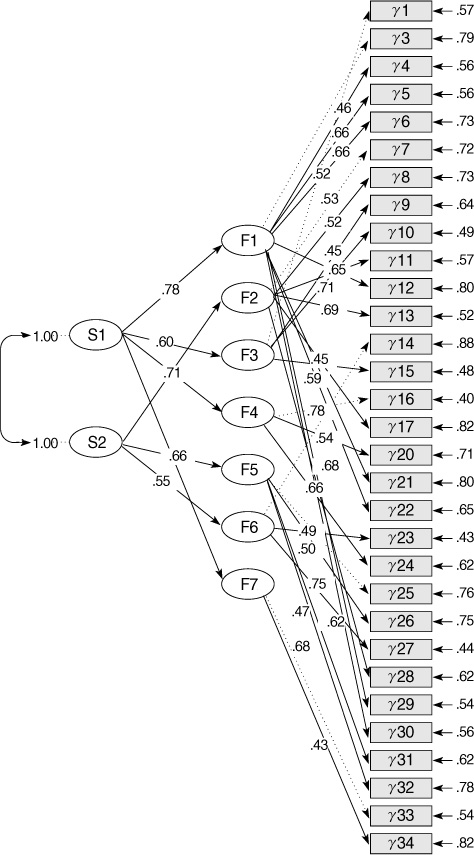
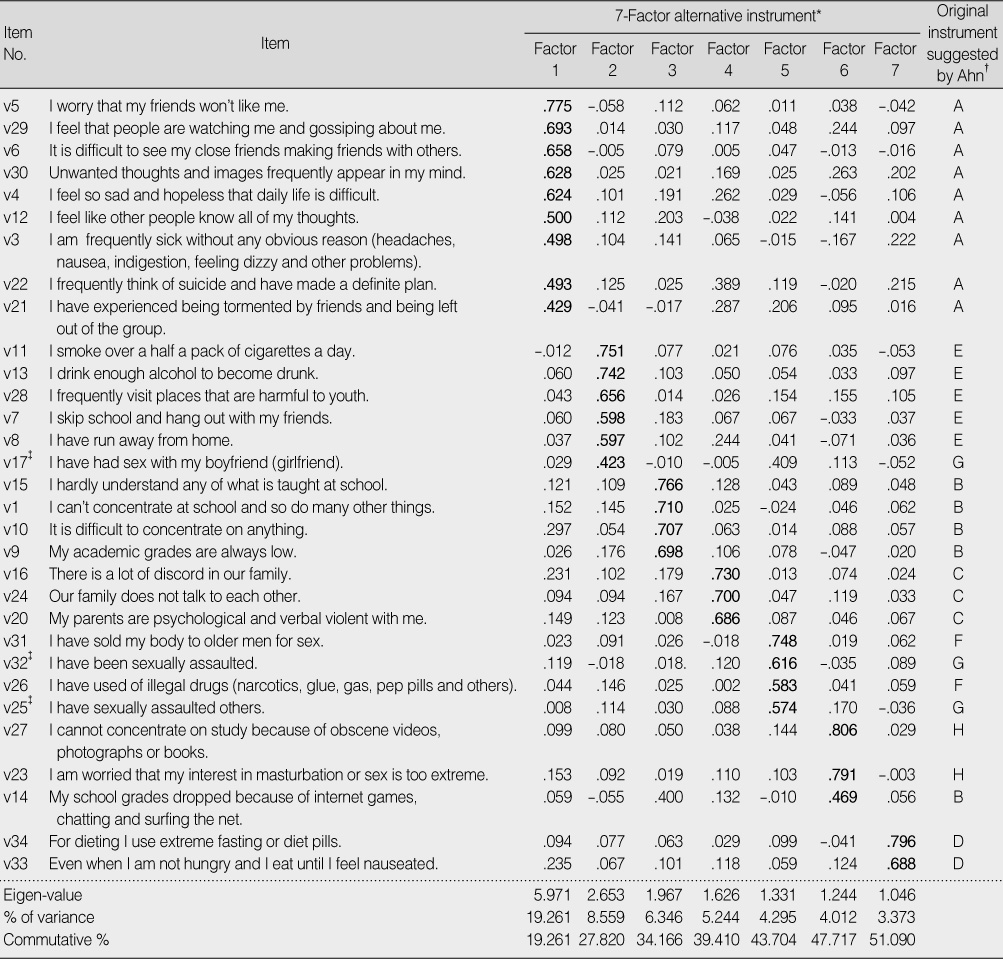
*Factor 1=psychiatric problems; Factor 2=delinquency; Factor 3=academic troubles; Factor 4=family problems; Factor 5=hazardous behavior; Factor 6=harmful circumstance; Factor 7=eating problems; †A=psychiatric problems; B=academic troubles; C=family problems; D=lose of control; E=delinquency 1; F=delinquency 2; G=sexual act; H=sexual need; ‡Different items compared with original instrument suggested by Ahn.
Figure & Data
REFERENCES
Citations

- Four-year trajectory of Korean youth mental health and impacts of school environment and school counselling: a observational study using national schools database
Seongjun Park, Dayoung Lee, Song Jung, Hyun Ju Hong
BMJ Open.2019; 9(11): e027578. CrossRef - Parents’ Knowledge and Attitudes Regarding a Screening Test for and Subsequent Management of Students’ Emotional and Behavioral Problems
Myung-Hee Kim, Ji-Min Seo
Child Health Nursing Research.2017; 23(2): 207. CrossRef - Influencing Factors on Externalized and Internalized Problem Behaviors among Adolescents: Focused on First Grade High School Students
Mi-kyung Yun, Eunyoung Park, Jung-A Son, Myung Sun Hyun
The Journal of Korean Academic Society of Nursing Education.2016; 22(2): 152. CrossRef - Effectiveness of school counseling based on "the AMPQ-II and administrative manual": Focusing on the counselor and the number of session factors
Ji Won Seul, Geunyoung Kim
Journal of the Korea Academia-Industrial cooperation Society.2015; 16(2): 978. CrossRef - Factors Affecting Mental Health and Behavioral Problems in High School Students: Based on a Social Cognitive Career Theory.
Hae Kyoung Son, Hyejung Lee, Miyoung Kim
Child Health Nursing Research.2014; 20(4): 314. CrossRef - Factors Influencing Emotional and Behavioral Characteristics of High School Students
Kyoung Sun Park, Gyu Young Lee
Journal of the Korean Society of School Health.2014; 27(2): 109. CrossRef - The Effects of the Neurofeedback training on the General health status, Mental health and problem behavior, and Brain function quotient among High school students
Heewook Weon, Jiyoung Lim, Hae Kyoung Son, Myung Ah Kim
Journal of the Korea Academia-Industrial cooperation Society.2013; 14(12): 6309. CrossRef - Characteristics of Type D personality in Korean adolescents
Moon-Soo Lee, Hong Euy Lim, Young-Hoon Ko, Changsu Han, Yong-Ku Kim, Jaewon Yang, Jeong Jin Kim, Jae Eun Lee, Jae Yeon Cha, Hongjae Lee
European Child & Adolescent Psychiatry.2012; 21(12): 699. CrossRef - Development of the Structural Model of Adolescent's Risk Behavior
Hyun Sook Park, Sun Young Jung
Journal of Korean Academy of Nursing.2011; 41(3): 364. CrossRef - Factors related to Problem Behaviors in High School Girls
Yeon-Hwan Park, Hye-Jin Hyun, Su Jeong Yu, Do-Hwa Byen
Journal of Korean Academy of Community Health Nursing.2011; 22(3): 315. CrossRef - Development of a Korean Risk Behavior Scale for Middle School Adolescents
Hyun Sook Park, Geum Yi Jo
Journal of Korean Academy of Psychiatric and Mental Health Nursing.2010; 19(2): 229. CrossRef

Figure 1
Result of Factor Analysis (Principal Axis Factoring-Varimax)
*Factor 1=psychiatric problems; Factor 2=delinquency; Factor 3=academic troubles; Factor 4=family problems; Factor 5=hazardous behavior; Factor 6=harmful circumstance; Factor 7=eating problems; †A=psychiatric problems; B=academic troubles; C=family problems; D=lose of control; E=delinquency 1; F=delinquency 2; G=sexual act; H=sexual need; ‡Different items compared with original instrument suggested by Ahn.
Correlations among Factors
Concurrent Validity of AMPQ
AMPQ=adolescent mental problem questionnaire; K-YSR=Korea-youth self-report.
Reliability Tests of Internal Consistency
*Factor 1=psychiatric problems; Factor 2=delinquency; Factor 3=academic troubles; Factor 4=family problems; Factor 5=hazardous behavior; Factor 6=harmful circumstance; Factor 7=eating problems; †A=psychiatric problems; B=academic troubles; C=family problems; D=lose of control; E=delinquency 1; F=delinquency 2; G=sexual act; H=sexual need; ‡Different items compared with original instrument suggested by Ahn.
AMPQ=adolescent mental problem questionnaire; K-YSR=Korea-youth self-report.
 KSNS
KSNS
 E-SUBMISSION
E-SUBMISSION
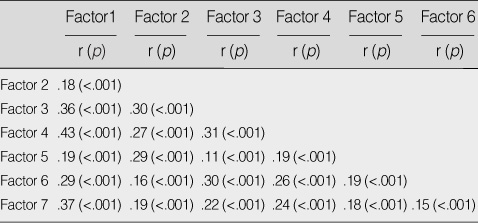
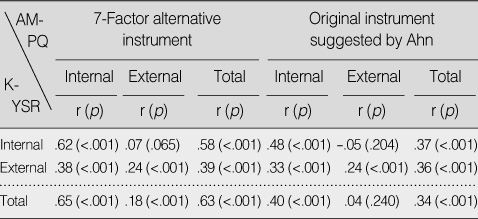
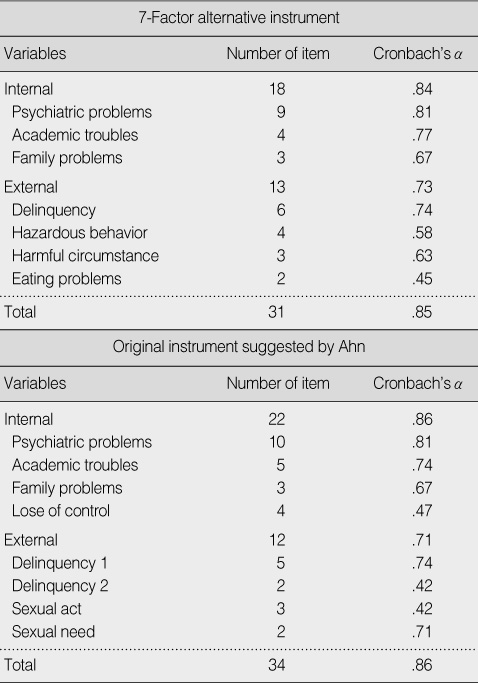
 Cite
Cite

